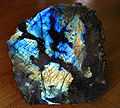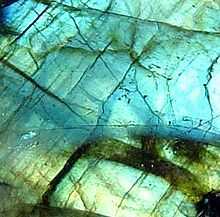Labradorite
| Labradorite | |
|---|---|
 Labradorite in a polished rock slab | |
| General | |
| Category | Feldspar, tectosilicate |
| Formula (repeating unit) | (Ca,Na)(Al,Si)4O8, where Ca/(Ca + Na) (% anorthite) is between 50%–70% |
| Crystal symmetry | Triclinic pinacoidal 1 |
| Unit cell | a = 8.155 Å, b = 12.84 Å, c = 10.16 Å; α = 93.5°, β = 116.25°, γ = 89.133°; Z = 6 |
| Identification | |
| Color | Gray, brown, greenish, blue, yellow, colorless |
| Crystal habit | Crystals typically thin and tabular, rhombic in cross section, striated; massive |
| Crystal system | Triclinic |
| Twinning | Common by Albite, Pericline, Carlsbad, Baveno, or Manebach twin laws |
| Cleavage | Perfect on {001}, less perfect on {010}, intersecting at near 90°; distinct on {110} |
| Fracture | Uneven to conchoidal |
| Mohs scale hardness | 6 – 6.5 |
| Luster | Vitreous to pearly on cleavages |
| Streak | white |
| Diaphaneity | Translucent to transparent |
| Specific gravity | 2.68 to 2.72 |
| Optical properties | Biaxial (+) |
| Refractive index | nα = 1.554 - 1.563 nβ = 1.559 - 1.568 nγ = 1.562 - 1.573 |
| Birefringence | δ = 0.008 - 0.010 |
| 2V angle | Measured: 85° |
| Dispersion | None |
| Other characteristics | Labradorescence (iridescent) |
| References | [1][2][3] |
Labradorite ((Ca, Na)(Al, Si)4O8), a feldspar mineral, is an intermediate to calcic member of the plagioclase series. It is usually defined as having "%An" (anorthite) between 50 and 70. The specific gravity ranges from 2.68 to 2.72. The streak is white, like most silicates. The refractive index ranges from 1.559 to 1.573. Twinning is common. As with all plagioclase members the crystal system is triclinic and three directions of cleavage are present two of which form nearly right angle prisms. It occurs as clear, white to gray, blocky to lath shaped grains in common mafic igneous rocks such as basalt and gabbro, as well as in anorthosites.
Occurrence
The geological type area for labradorite is Paul's Island near the town of Nain in Labrador, Canada. It has also been reported in Norway and various other locations worldwide.[2]
Labradorite occurs in mafic igneous rocks and is the feldspar variety most common in basalt and gabbro. The uncommon anorthosite bodies are composed almost entirely of labradorite.[4] It also is found in metamorphic amphibolites and as a detrital component of some sediments. Common mineral associates in igneous rocks include olivine, pyroxenes, amphiboles and magnetite.[1]
Labradorescence

Labradorescence is a side-effect of the molecular change which occurs in large crystal masses of anorthosite, producing an iridescent play of colors similar to adularescence. This labradorescence, or schiller effect, is the result of light diffraction within the lamellar intergrowths – fine, adjacent layers of the separate materials (lamellae) comprising the whole rock phase – created when conditions do not allow for sufficient diffusion to the materials' equilibrium composition.
The cause of this optical phenomenon is phase exsolution, or phase (state) instability, occurring in the Bøggild miscibility gap (An48-An58); under the appropriate heat and pressure conditions the separate molecular components will coexist but not mix to a solution, producing the phenomenon. [5][6][7][8]
Gemstone varieties of labradorite exhibiting a high degree of labradorescence are called spectrolite.
Gallery
-

Labradorite, Ylämaa, Finland -

Polished labradorite 18x20cm – Madagascar -

Detail of Labradorite -
.jpg)
Polished labradorite from UCL Geology collections
References
- ↑ 1.0 1.1 Handbook of Mineralogy
- ↑ 2.0 2.1 Mindat.org
- ↑ Webmineral data
- ↑ Hurlbut, Cornelius S.; Klein, Cornelis, 1985, Manual of Mineralogy, 20th ed., Wiley, p. 456 ISBN 0-471-80580-7
- ↑ http://goldbook.iupac.org/MT07230.html
- ↑ Phase_transition
- ↑ Miscibility
- ↑ https://www2.imperial.ac.uk/earthscienceandengineering/rocklibrary/viewglossrecord.php?gID=00000000345
| Wikimedia Commons has media related to Labradorite. |